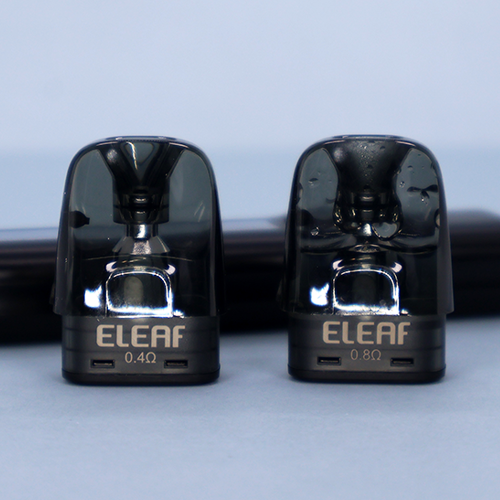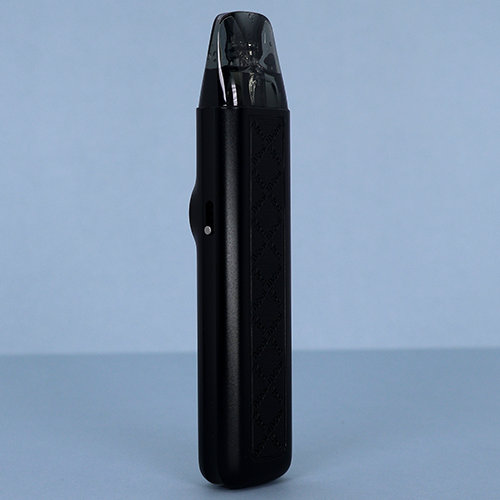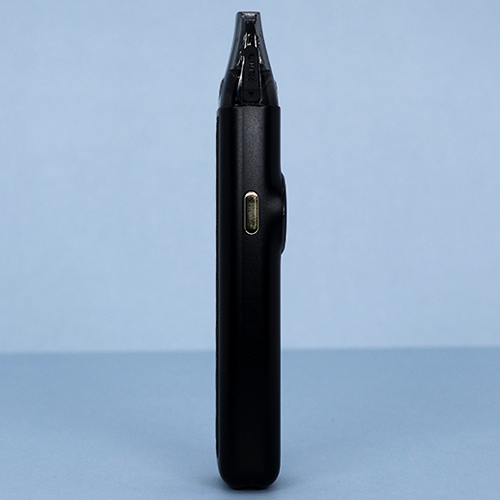Eleaf iVeni

4.5
Outstanding
PROS
- Simple to set up, adjust, and use
- Solid and attractive design and construction materials
- Large, bright, uncomplicated LCD screen
- Button or draw-activated
- Great flavor and vapor production from the iVeni pods
- Accurate and resistant adjustable airflow slider
- Excellent for both RDL and MTL vaping
- Adjustable wattage between 6W and 40W
- 1100mAh battery provides up to two days of use
- 2A USB Type-C provides fast (<35 minutes) recharging
CONS
- Only four pod resistances to choose from
- No exact battery percentage readout
- Rounded base makes it hard to stand upright
The bottom line
As someone who has only used a couple of ELEAF vapes in the past, and none in the last few years, I was pleasantly surprised by how much I liked the iVeni and how “premium” it looked, felt, and performed. The solid weight of the device, which is by no means too heavy, instantly makes it feel high quality, and this impression is quickly backed up by the feel of the matte metal unibody, smooth edges, and leatherette panel.
It doesn’t have superfluous features like animated screens and lanyard loops, but the features it does have provide both an RDL and MTL vaping experience that is as solid as its construction. The range of pods is fairly small, with just four different resistances offered, but these pretty well cover what most users will want for these vaping styles.
The pods seem reliable and leak-free, providing great flavors and a satisfying throat hit from your vape liquid. The coils fire efficiently and have no lag, even with the low-resistance pods and open airflow, no matter if using draw or button activation. The chimney in the mouthpiece is fairly short, but despite this, I rarely noticed any spitback or e-liquid in my mouth.
I could, on a personal preference level, take issue with the rounded base, but that isn’t likely to be a problem for most users, and it certainly doesn’t detract from how well thought-out everything else about the device seems to have been.
If you were to ask me, “Would you recommend the iVeni to close friends and family?”, my resounding answer would be “yes!”. If you are looking for a solid, reliable pod vape and enjoy either RDL or MTL vaping, the ELEAF iVeni should certainly be considered.
Approx. Price: $20 USD
Product Overview
The ELEAF iVeni is the flagship pod device of the relatively new iVeni range, sitting alongside the iVeni SE and iVeni Lite. All three devices in the iVeni range share a few of their characteristics, including the tall, slim form factor, battery size, and charging technology.
The iVeni features a 1100mAh battery and a 2A fast-charging USB Type-C port, just like its siblings, but it also offers a full-color LCD screen, dual activation, and a higher-quality build. It is designed to be used as either an MTL or RDL vape and comes with a couple of pods to suit those styles.
Four resistances are currently available, ranging from 0.4Ω to 1.2Ω, but the 0.4Ω and 0.8Ω versions are included in the box. As might be expected, these four pod types can be used across the entire range of iVeni devices.
Having used a couple of the more advanced ELEAF devices several years ago, but nothing in recent times, I was very interested in getting my hands on one of their MTL/RDL pod devices. Here’s how my two weeks of testing the ELEAF iVeni went.
This product was sent to me directly by Eleaf for this review. However, this does not affect my thoughts or opinions on this device.
- 1 x ELEAF iVeni Device
- 1 x iVeni 0.4Ω Pod (2ml)
- 1 x iVeni 0.8Ω Pod (2ml)
- 1 x USB Type-C Cable
- 1 x User Manual
- 1 x Warranty Card
- Size: 117mm x 25.8mm x 16.6mm
- Weight:
- Pod Capacity: 2ml
- Button or Draw activated
- RDL to MTL draw
- Battery Capacity: 1100mAh
- Wattage Range: 6W-40W
- Adjustable Wattage
- Adjustable Airflow Slider
- Charging: 2A Type-C
Design & Build Quality
The design of modern MTL/RDL pod vapes has settled into a standard that most users seem happy with. There are always outliers and nano designs, but most popular pod vapes now follow the tall, slim form factor that has been the norm for several years. The ELEAF iVeni, on first impressions, fits well within that standard.
At 117mm tall and 25mm wide, it is almost identical in size and shape to vapes like the OXVA Xlim Pro 2, Innokin Trine, and VAPORESSO XROS 4. Where the iVeni does deviate slightly is in its weight.
At just over 90g, it’s heavier than all three of those previously mentioned devices, and the weight and solidity were the very first things that struck me upon lifting it out of the box. Personally, I prefer using a device that has a bit of heft, but if you like ultra-lightweight vapes that you can’t even feel in your pocket, it might take a bit of getting used to.

The iVeni is currently available in five different colorways: Cyan, Black, Green-Blue Gradient, Gunmetal, and Purple Gradient. All of them look fantastic and pretty classy overall, and all of them feature several thoughtful design elements.
These include a polished chrome panel on the front (below the display) and a full-length leatherette inset panel on the back. I didn’t, at first, understand the point of this leather-like panel beyond it being a style choice, but after just a few minutes of use, the reason for its inclusion became clearer.
One of my pet hates in pod vape design is a base that isn’t flat. I like to have my vape standing upright when it’s not in my pocket, and so a flat base is always one of the first things I look for in a device. The iVeni’s base is squared off, but with a very slight curve across its width.
It can stand up, but it’s very unstable, and the slightest knock will send it toppling over. So if standing up isn’t an option, the natural alternative is lying it down on the leatherette pad (leaving the display facing up), which cushions the vape and the surface it is laid on, and stops it from sliding around. It’s not perfect, in my opinion, but it makes sense if standing upright isn’t an option.
Pods

The ELEAF iVeni kit comes with two pods, a pre-installed 0.8Ω and a 0.4Ω pod in the box. There are a total of four resistances available in the iVeni pod range, so if those don’t work for you, you have the option of buying 0.6Ω or 1.2Ω versions.
All of the iVeni pods are compatible with the other iVeni devices: the iVeni SE and iVeni Lite. This range of available resistances makes it very possible to use the iVeni as anything from an RDL to a tight MTL vape.
The pods use the now-common duck-bill design with a wide and narrow mouthpiece. The fill port is on the side of the pod, above the top edge of the slot, so you can refill without removing the pod from the battery.
Magnets hold the pod in place very securely, and although there is a bit of movement of the pod within the slot, they don’t feel like they are ever in danger of accidentally coming loose. ELEAF has thoughtfully added two indentations low down on the flat faces of the pod for extra grip. So, while the magnets are strong, even sweaty fingers can get a firm enough grip to pull the pod out when needed.
The pods are tinted, but not so much that you can’t see how much liquid is in the reservoir. They only hold 2ml of vape juice, but the entire amount can be seen above the top edge of the slot. Combined with the side fill port, that means that once a pod is inserted, you’ll barely need to remove it until it’s time for a new one.
ELEAF doesn’t provide an expected lifespan for the pods/coils in its iVeni documentation (as far as I can tell, anyway), but I have been using both the 0.8Ω and 0.4Ω pods interchangeably for two weeks, and both are still going strong. Flavor and vapor production are still good, and leaking has been almost nonexistent.
I would expect the 0.4Ω to die first, as this is having 35W put through the coil compared to 20W in the 0.8Ω, but my tests suggest that the average vaper should get up to two weeks of use from each pod.
Features

The ELEAF iVeni isn’t a complex device, but it does have a few practical and quality-of-life features worth mentioning. The most obvious and prominent of these is the ample, circular display on the front of the device.
The LCD screen is relatively large and pleasingly bright. Although it doesn’t contain as much data as some vapes, everything you need for a good vaping experience is clearly shown.
This data includes battery level, wattage, button lock status, and power level. There are also a couple of curved coloured bars at the top and bottom that change color when you draw on the mouthpiece (or press the button).
Wattage can be changed by pressing the button three times, then scrolling through the levels to the one you want. Min and max wattage are automatically restricted by the pod currently in use, so, for example, the 0.8Ω pod can only be used between 13W and 20W.
When you pop in the 0.4Ω pod, that range changes to 28W to 40W. The vape has dual activation, button press or draw, but you can restrict this to draw only by locking the button. The full list of button functions includes:
- Click and hold – Activation
- 3 Clicks – Adjust wattage
- 4 Clicks – Button lock
- 5 Clicks – Turn on/off device
On a level with the screen, on the opposite side of the vape to the control button, is the adjustable airflow slider. The airflow slider has a good level of resistance, making it easy to choose an airflow level and have it stay at that level. There are three air holes on the slider, giving you a good range of options depending on the pod being used and your preferred vaping style.
The only other feature visible on the outside of the iVeni is the UCB Type-C port located on the base, but more on that below.
Battery life & Charging

Given the weight of the iVeni you might think that it has a huge battery inside, as this is usually where most of the weight of a small vape comes from. Somewhat surprisingly, there’s actually only a 1100mAh cell in this device. That is by no means a small capacity battery, indeed, it’s about the average for this type of pod vape, but I have to admit I was expecting something bigger based on its weight in my hand.
The battery life is about as good as can be expected from this capacity. It won’t be winning any longevity awards, but a full charge will easily provide a full day of vaping to all but the heaviest users running it at max wattage.
In my testing with the 0.8Ω pod at 18W-20W, a full charge lasted for close to two days on average. When using the 0.4Ω pod at 35W, a full day of use was easily achieved, and often there was still charge remaining for several hours of use on the second day. If you are a low-wattage, high-resistance MTL vaper, two days from a full charge won’t be a problem.
Recharging is very fast thanks to the 5V/2A USB Type-C port. Charging from the low battery warning to full took just 34 minutes on average. Charging from two bars remaining was often as short as 10-15 minutes. And of course, the iVeni has all the expected safety features like charge shut-off when the battery is full.
Performance

From having had several different preferred vaping styles, I am firmly in the RDL camp these days. It’s how I vape on a daily basis when I’m not testing and reviewing devices designed for different styles.
Although I was half expecting the iVeni to be more MTL than RDL, I was pleasantly surprised by how well it performed as the latter with the right setup. The sweet spot for me was the 0.4Ω pod, fully open airflow, and 35W. This setup provided an extremely satisfying RDL vape that suited me from morning until night.
That’s not to say that this device won’t suit MTL vapers too, because I believe it will. Although I only got to test the 0.4Ω and 0.8Ω pods, the 0.8Ω with the airflow half closed provided a great MTL vape. I can only assume that the 1.2Ω pod would even better provide the sort of resistance many recent ex-smokers look for in an e-cigarette.
The coils in both of the pods I tested performed well and appear to be lasting well after around a full week of use with each. The flavor production is great, and you can produce decent clouds if you dial up the power on the 0.4Ω and open the airflow.
The fill port bung is pretty small and might be a bit fiddly to open if you have big fingers, although there is a little tab to get your fingernail under. Once closed, the bung feels secure, and I experienced no leaking from the port, nor indeed from anywhere else.
Leaking pods used to be the bane of my vaping life, but modern pods are now generally so good that users rarely need to worry. As someone who has not used many ELEAF devices, I am glad to find this is as true with the iVeni as it is with most other popular pod vapes.
Verdict
As someone who has only used a couple of ELEAF vapes in the past, and none in the last few years, I was pleasantly surprised by how much I liked the iVeni and how “premium” it looked, felt, and performed. The solid weight of the device, which is by no means too heavy, instantly makes it feel high quality, and this impression is quickly backed up by the feel of the matte metal unibody, smooth edges, and leatherette panel.
It doesn’t have superfluous features like animated screens and lanyard loops, but the features it does have provide both an RDL and MTL vaping experience that is as solid as its construction. The range of pods is fairly small, with just four different resistances offered, but these pretty well cover what most users will want for these vaping styles.
The pods seem reliable and leak-free, providing great flavors and a satisfying throat hit from your vape liquid. The coils fire efficiently and have no lag, even with the low-resistance pods and open airflow, no matter if using draw or button activation. The chimney in the mouthpiece is fairly short, but despite this, I rarely noticed any spitback or e-liquid in my mouth.
I could, on a personal preference level, take issue with the rounded base, but that isn’t likely to be a problem for most users, and it certainly doesn’t detract from how well thought-out everything else about the device seems to have been.
If you were to ask me, “Would you recommend the iVeni to close friends and family?”, my resounding answer would be “yes!”. If you are looking for a solid, reliable pod vape and enjoy either RDL or MTL vaping, the ELEAF iVeni should certainly be considered.
Approx. Price: $20 USD



















Add comment